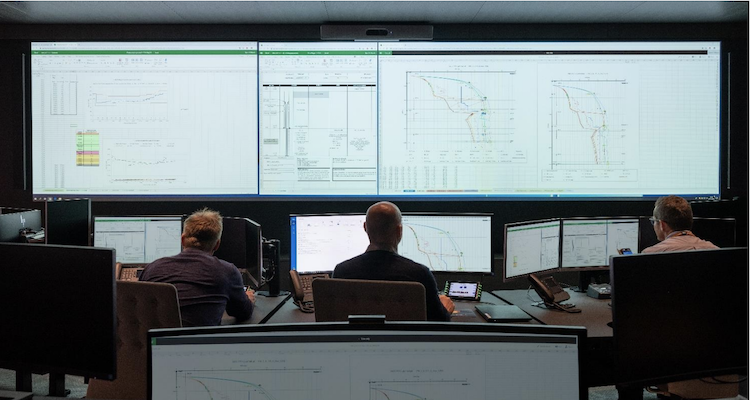Aker BP’s New Flexible and Multipurpose Onshore Collaboration Center

After 10 years of service, Aker BP’s Onshore Operation Center (OOC) had become too limited in capacity, and an upgraded space was needed to handle more rig lines and improve collaboration. Aker BP’s ambition was to build a new world-leading Onshore Collaboration Center (OCC) in Stavanger for its Drilling & Wells operations, designed to support ever-changing workflows and the digitalization of processes. The OCC will act as a central location for Aker BP’s expertise in well placement, real-time operations, geo-steering, autonomous drilling, and the execution of the well versus the Digital Twin. It will also be the repository for rig connectivity and rig-to-shore IT support.
‘Our ambition for the OCC is to put us in the top 5% of operators worldwide for collaborative environments and remote operations. With this project we wanted to be cutting edge, to take ourselves out of our comfort zone and do things differently.’ Andy Deady, OCC Lead
Business benefits for Aker BP
The main investment vehicle was based on a BSEE report after the Macondo incident. The report found that the ROI for vendors and operators who invest in collaboration centers in oil and gas and well construction has been measured to reduce Non-productive Time (NPT) by 2.5% over a year. The tangible business benefits in adopting such a collaboration center or a real-time center is twofold: reducing invisible lost time (ILT) and increasing productivity by having everyone in the same room, using the same information, bridging the team onshore and offshore, and creating a shared situational awareness. Bringing down ILT (invisible lost time) and NPT (non-productive time) can reduce the well cost by 5%.
A new way of designing collaboration centers
The new Aker BP OCC is designed with the ethos of allowing the team to enter an environment, use it and leave if need be, but have a core team that is always located in that room, which provides greater flexibility. The environment is designed around the inputs of operators and specialists, based on their experience in the existing OOC and their needs for more collaboration and flexible design. Partners were also both part of the concept and detailed design phase, inputting how they would be interacting with the systems, and how they would be connected their applications.
A flexible solution based on standardization, infrastructure, and display technology
The Cyviz solution is based on 13 systems, all interconnected with a new generation IP-based infrastructure for routing and data distribution. The uniqueness of the solution resides in the flexibility of this new architecture, but also in the standardization principles applied to the design, and deployment of the solution.The flexibility is also reflected in the display technology favored. Seamless projection with video processing, allowing multiple dynamic PiPs (Picture-in-Picture) to be added, moved and shared across rooms. The system design also had to support the two levels of access to wells’ information, with unrestricted access and tight wells, which implies severe access restrictions.
Standardization: A future-proof solution
In contrast to the traditional approach where the control system software is customer specific, the Cyviz software platform is standardized, configurable and upgradeable, reflecting Aker BP’s culture of continuous improvement. The value of standardization for Aker BP is threefold. Firstly, it meant that Aker BP’s technical lead could take full responsibility for post-installation management, support, and maintenance tasks. All configurations and adjustments to ongoing operations can be made in-house with more speed and efficiency, instead of having external support coming in for re-programming. With standardization, Aker BP has full ownership of their solution. Secondly, it meant that the software platform powering the entire OCC was upgradeable and future-proof. This was a strategic and cultural direction meaning that Aker BP could better manage, support and improve the OCC as organizational changes occur over time. Finally, as reliability and uptime were also key requirements from Aker BP, the high level of standardization simplified and cut time on the implementation process and will enable predictive maintenance.
IP-based infrastructure and information highway
Superior video and audio quality means travelling to customer sites or between offices is much reduced, saving time and money as well as reducing Aker BP’s carbon footprint. A new IP infrastructure was developed by Cyviz, preferred to a traditional AV matrix approach that would have been too specialized and too rigid. The solution needed to be innovative and based on IT principles with a simple distribution over IP. Changing the signalling distribution and avoiding the rigidity of cabling and matrix, resulted in an ‘information highway’, allowing Aker BP to handle and distribute all data and information, making it possible to work on digital assets with much more flexibility.
‘The innovative design for the AV over IP that Cyviz came up with really stood out as a differentiator and impressed us.’ Andy Deady, OCC Lead


